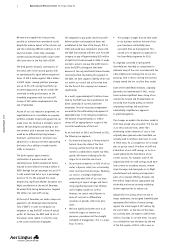Aer Lingus 2010 Annual Report Download - page 20
Download and view the complete annual report
Please find page 20 of the 2010 Aer Lingus annual report below. You can navigate through the pages in the report by either clicking on the pages listed below, or by using the keyword search tool below to find specific information within the annual report.
18
Annual Report 2010
Safety and Security Statement Aer Lingus Group Plc
Health, Safety and Security
Organisation
Safety is a corporate value of Aer Lingus, and
we are committed to maintaining a safe,
healthy and sustainable working environment
wherever we operate – for our staff, our
customers and the public. We actively manage
safety as an integral part of all operations,
both in the air and on the ground. We are
committed to implementing, developing and
improving strategies, management systems and
processes to ensure that all our activities
uphold the highest level of safety performance.
In order to fulfi l the commitments explicit in
the Aer Lingus Safety Policy, management will
enforce the requirement to proactively manage
risk in the control of all activities of personnel
and of the use of resources that are directly
related to, or necessary for, the delivery of
service to our customers. Recruitment
practices, training and supervision of
employees, and the procurement of equipment
to support service delivery activity are all
factors in the successful management of
safety. Aer Lingus management will ensure
that all staff adhere to safety policy and
controls, and that their working environment
remains conducive to carrying out their
assigned duties.
The Aer Lingus Safety Management System
(“SMS”) as described in the Air Safety Manual
provides the mechanism for management to
deliver on this commitment.
Aer Lingus’ SMS is directed by the Safety
Manager. This role reports directly to the Chief
Executive, ensuring continued accountability
and awareness of these issues and their
importance within the Group. The Safety
Manager has responsibility for the coordination
and oversight of the key SMS components; Air
Safety, Health and Safety, Security, Quality
Assurance and Emergency Response Planning
The Aer Lingus SMS is subject to an ongoing
continuous improvement programme. In 2010,
as part of the wider Corporate restructuring,
the key focus for the Safety Manager was
redirected towards the core function of fl ight
safety and accident prevention. Other key
components of the SMS now directly report
into other departments within the Company,
with the Safety Manager maintaining oversight
of the entire system. Continued further
investment in the SMS was also delivered,
through recruitment to the Air Safety Offi ce
(“ASO”) staff and realignment of some
business practices, including Flight Data
Monitoring (FDM) into the ASO.
The Group places great emphasis on proactive
and predictive systems to manage safety. The
SMS involves the ongoing routine collection
and analysis of safety data during the ordinary
course of business, which enables proactive
management. This includes a Flight Data
Monitoring Programme, a Confi dential Air
Safety Reporting System and a specifi c Hazard
Identifi cation and Risk Analysis (HIRA)
programme. The principles of air safety
management are integral to all Aer Lingus’
training programmes. Courses are designed
around the prevention of accidents and cover
all aspects of fl ight operations, including the
handling of dangerous goods, aviation security
and emergency response planning. Staff
training in all operational departments is
mandatory. Training records and processes are
regularly subject to external review and audit.
Aer Lingus is subject to regular safety reviews,
in particular, from the Irish Aviation Authority
(IAA) and other airlines.
In 2010, the Air Safety offi ce was successful in
delivering training to all operational divisions,
including North America, with a resultant
increase in safety reporting across the
network.
Aer Lingus is now registered as an IOSA
Operator under the IATA Operational Safety
Audit Programme. The IOSA programme is
an internationally recognised and accepted
evaluation system designed to assess the
operational management and control systems
of an airline.
Aircraft maintenance, repair and overhaul are
critical to the safety and comfort of Aer Lingus’
passengers, the effi cient use of its aircraft and
the optimisation of its fl eet utilisation. The Aer
Lingus maintenance system is subject to
repeated audit inspections by the IAA.
There is a programme of continual review to
ensure ongoing compliance with the Safety,
Health and Welfare at Work Act 2005, and the
General Applications Regulations 2007 and with
all relevant safety regulations, as well as the
integration of Health & Safety into the Airline’s
fl ight safety & accident prevention programme.
Information and advice for customers on air
travel and health is available on the Group’s
website, www.aerlingus.com, in the in-fl ight
magazine, Cara, and through on-board
announcements and videos.
Air Safety
Aer Lingus’ Air Safety Offi ce acts as an
independent monitor of air safety risk
management. This offi ce focuses on accident
prevention and hazard and risk analysis and
also promotes best practice and awareness
throughout the Group. The Air Safety Offi ce is
also responsible for management of Flight Data
Monitoring. This is a safety process whereby
fl ight performance is regularly monitored to
identify any areas of risk and is used in both
operational and maintenance planning. The Air
Safety Offi ce operates the Group’s Air Safety
Reporting System, its Incident and Happening
Database and a Confi dential Air Safety
reporting system.
Safety and Security Statement
























